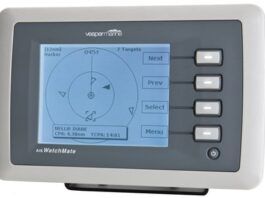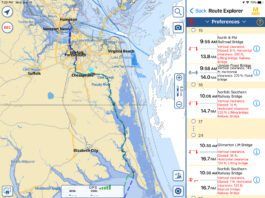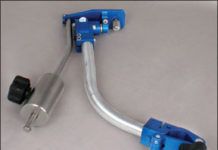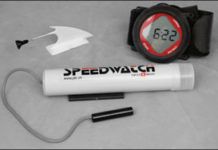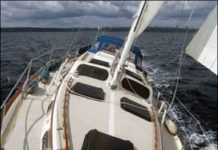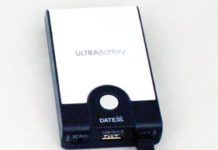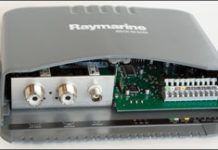Stabilizing Cameras and Video Cameras Underway
Anyone who has tried to steady a camera aboard a boat knows how difficult it can be to keep the equipment dry, compose the shot, and level the horizon, all the while keeping yourself and your camera on board. Given hull vibrations, wave action, and the unevenness of the deck, setting up a stable work platform presents challenges that marine photographers try to solve using a variety of camera mounts. Practical Sailor recently tested three types of camera mounts: a beanbag camera mount from Omnipod, the Camo-Pro 7; two flexible devices from GorillaPod, the heavy-duty GorillaPod Focus and the GorillaPod SLR Zoom; and specialized, self-leveling camera mounts from Horizon True.
Portable Sailing Tools for Tracking and Tuning Boat Speed
Practical Sailor recently spent a week experimenting with three handheld products geared toward performance sailors. These portable tools are for tracking and improving sailboat speed. Unlike conventional portable GPS units, which have relatively small displays and deliver a wide range of navigational data, these products display large digits that can be read from a distance, and the view options are limited to those that relate exclusively to speed and racing performance. Practical Sailor tested the Speedwatch and two GPS units, Velocitek SC-1 and SpeedPuck. These instruments make good training tools for young sailors and will give all around-the-buoy sailors the ability to quickly quantify performances.
Mailport: February 2010
The February 2010 issue of Practical Sailor has letters on the following topics: requests for more used boat reviews, foggy electronics, hard varnishes, propane fridges and Iphone apps.
Multiplexing Marine Electronics
In an effort to find an inexpensive, reliable way to connect a PC (or Mac) to our onboard electronic navigation system, Practical Sailor testers scouted basic NMEA 0183 multiplexers with good track records. We zeroed in on the easy-to-install MiniPlex Lite from Holland-based ShipModul. This multiplexer was one of the first high-speed NMEA 0183 multiplexers capable of handling the data rates required for some of the newer electronics like AIS receivers. With very little effort, the Mini Plex Lite allowed us to network our Dell Latitude D620 laptop, AIS, GPS, and chartplotter, and it handled the data transfer without a glitch. Our chief gripe: This entry-level model uses the laptop for its power source.
GPS Receivers for Smart Phone Navigators
During our testing of pocket navigators for the December 2009 issue, we examined other approaches to propagating a GPS signal around the boat and found some viable alternatives. Several aftermarket options can turn smart phones or PDAs into handheld navigation tools by supplying or sharing reliable GPS data. Practical Sailor looked at a Bluetooth-enabled Globalsat BT-338 GPS receiver with the SiRFStarIII chipset and Franson Technology’s GPSGate software for Windows and Windows Mobile, which was designed specifically for the task of sharing GPS data. Testers found both utilities to be good choices for the job, however, we still caution against relying solely on a PC-based navigation network onboard.
New Waterproof Handheld VHFs Enter Crowded Market
Electronics is the most rapidly changing category of marine products, and the steady stream of VHF radios is an example of how fast the market changes. Since our reports on VHF radios earlier this year, two new waterproof handheld VHF radios have entered the market. Practical Sailor compares the new, inexpensive Standard Horizon HX28OS to the 2009 Best Choice, the Cobra HH325VP. Testers compared the new floating handheld from Icom, the M36, to the high-end Best Choice, the Standard Horizon HX85OS, a floating VHF that also offers full DSC capability and has a built-in GPS.
Testing Smart Phones at Sea
Practical Sailor tests a cross-section of PDAs, pocket PCs, and smart phones between $100 and $800. Palm OS and Windows Mobile software were included. Readability, functionality and practical application were foremost considerations. Reliability, weather resistance, and batteries were also considered. We evaluated Palm Phones Palm Treo, Hewlett Packard iPAQ, Palm PDA Palm TX, Active Captain MobileSource, Memory Map Navigator, and Ozi Explorer CE. Testers compared the mobile devices to a handheld GPS specifically designed for navigation, the Garmin Oregon 400C.
Stocking Stuffers For Sailors
Its hard to believe, but the 2009 holiday season is upon us. As is custom, Practical Sailor editors have put together a varied roundup of gifts to stuff those stockings more likely to hang from a bulkhead than the mantle. For the racing or small-boat sailor whos making the leap from wire rope to high-tech fiber, Colligo Marines Softies offer a lightweight alternative to traditional steel shackles and headsail hanks. Made of extra strong and chafe-resistant Dyneema, the "soft" hardware is the perfect solution for use with synthetic forestays, and unlike metal hanks, theyll never leave rust stains on sails. Using the Softies is as easy as pulling the shake-resistant knot through the expandable spliced loop, then sliding the slip ring (rubber O-rings) up to the knot. A lanyard ensures easy opening, but the self-tightening O-rings offer added security against accidental opening or shaking loose.
Top-of-the-Line VHFs Packed with Multi-function Features
The fixed-mount marine VHF radios tested for this review go beyond the basic capabilities of moderately priced VHFs. The waterproof VHFs include features such as integral high-wattage hailers, multiple remote microphone connections, and the capability to store MMSI numbers. They also meet Class D standards for DSC functions, with two separate receivers-one for voice communications and a second to continuously monitor channel 70 for DSC calls. The five VHF radios tested were the Icom M504, Icom M604, Standard Horizon GX5000S, Standard Horizon GX5500S, and the Raymarine 218.
Practical Sailor Tests AIS Class B Transceivers from West Marine and Navico
Practical Sailor last looked at Automatic Identification Systems, or AIS, in November 2008, reviewing the Raymarine AIS250, a receive-only device. Since that report, the pool of AIS products has grown to include several affordable transceiver options for recreational sailors. In this head-to-head test, we review two AIS-Class B devices capable of sending and receiving AIS data: the Navico NAIS-300 and the West Marine AIS1000. AIS transceivers are split into Class A (commercial) and Class B (recreational). AIS devices improve safety at sea by receiving and broadcasting a wide variety of information about a ship, including its name, latitude and longitude, course over ground, speed over ground, heading, status, and Maritime Mobile Service Identity (MMSI) number.
































